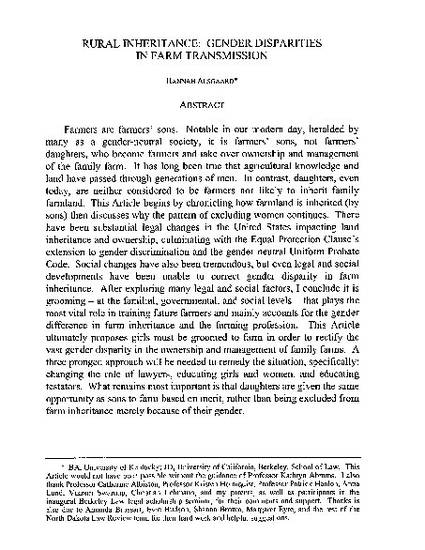
Article
Rural Inheritance: Gender Disparities in Farm Transmission
88 North Dakota Law Review 347
(2012)
Abstract
Farmers are farmers' sons. Notable in our modern day, heralded by many as a gender-neutral society, it is farmers' sons, not farmers' daughters, who become farmers and take over ownership and management of the family farm. It has long been true that agricultural knowledge and land have passed through generations of men. In contrast, daughters, even today, are neither considered to be farmers nor likely to inherit family farmland. This Article begins by chronicling how farmland is inherited (by sons) then discusses why the pattern of excluding women continues. There have been substantial legal changes in the United States impacting land inheritance and ownership, culminating with the Equal Protection Clause's extension to gender discrimination and the gender-neutral Uniform Probate Code. Social changes have also been tremendous, but even legal and social developments have been unable to correct gender disparity in farm inheritance. After exploring many legal and social factors, I conclude it is grooming - at the familial, governmental, and social levels - that plays the most vital role in training future farmers and mainly accounts for the gender difference in farm inheritance and the farming profession. This Article ultimately proposes girls must be groomed to farm in order to rectify the vast gender disparity in the ownership and management of family farms. A three pronged approach will be needed to remedy the situation, specifically: changing the role of lawyers, educating girls and women, and educating testators. What remains most important is that daughters are given the same opportunity as sons to farm based on merit, rather than being excluded from farm inheritance merely because of their gender.
Disciplines
Publication Date
2012
Citation Information
Hannah Alsgaard, Rural Inheritance: Gender Disparities in Farm Transmission, 88 N.D. L. Rev. 347 (2012)
